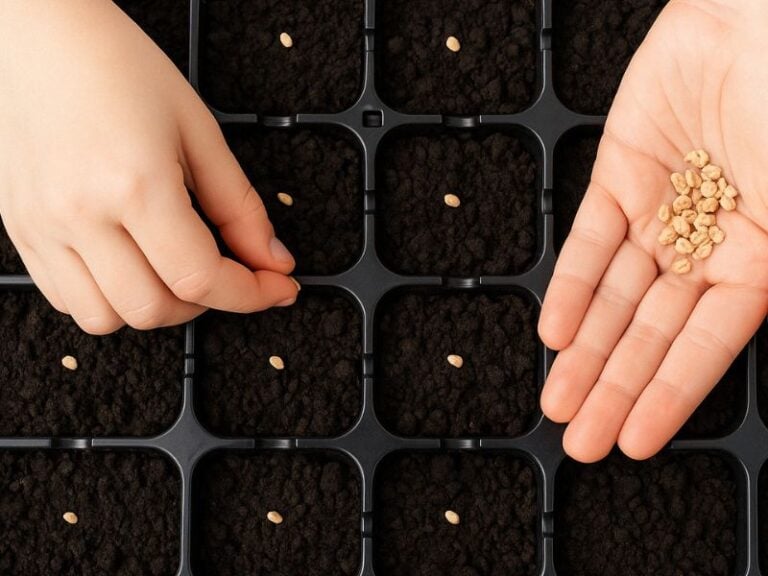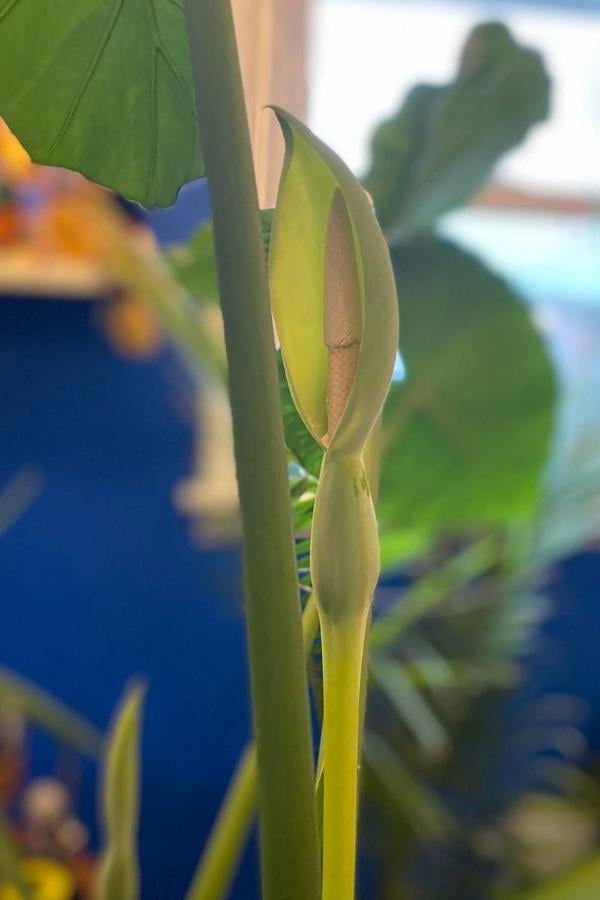Beautiful flower clusters from birds of Paradise are often used in bouquets, but the plants can also be grown indoors.
It has lovely flowers that resemble birds, but it is mainly grown for its foliage in-home.
However, to add a touch of tropical flair to your yard and house, consider adding some plants that resemble the bird of Paradise to your collection.
Bird of Paradise (Strelitzia) vary widely in appearance. Depending on the variety, the height and color of the flowers can be different as well.
There are five most common varieties, all of which originate in South Africa and belong to the Strelitzia family. If you’d like to learn more about those five species, check out this article.
Here is a list of plants that look like bird of Paradise but are different species:
Contents
1. Traveler’s palm (Ravenala madagascariensis)
The Strelitziaceae family includes the species Ravenala madagascariensis, also called “Traveler’s Palm.”
Although it has the appearance of a palm tree, it is a hybrid of a banana tree and a palm tree.
It is related to the bird of paradise, and its name comes from the fact that rainwater collects on its leaves and runs down to its base, where travelers can drink it. Each can hold a quarter-liter of water.
Large leaves that unfold into a fan or peacock-like shape characterize this Madagascar-only plant’s distinctive appearance.
It makes you think of faraway and tropical places when it’s around.
The traveler tree is widely used in landscaping and is an excellent plant for a more severe environment.
It is a plant with a strong presence that will not go unnoticed.
Technical Characteristics
Despite its sculptural appearance, the Traveler’s Palm is semi-woody. Its vast, banana-like leaves are popular in gardens.
They can form an elegant and unique dark green fan when lined up.
The flowers grow in 8–20 clusters of upright, long inflorescences. Each of them (what we call the flower) contains 4 to 8 flowers protected by an elongated beak-shaped bract.
The flowers are made up of three free and equal outer tepals and three welded, unequal inner tepals, one of which is positioned around the style.
The fruits are extended capsules with three open valves to reveal the blue seeds inside.
| Scientific name | Ravenala madagascariensis |
| Other names | Traveler’s tree, Traveler’s palm |
| Origin | Madagascar, africa |
| size | From 30-50 feet (9-15 meters) tall |
| Life cycle | Perennial |
| Flowering | Autumn |
| Climate | Tropical |
| USDA zones | 10 to 11 |
Where And How To Grow?
The best time to plant a traveler’s palm is in late winter. When the flowers are fully open in the fall, flowering happens. For best growth, it needs to be in the sun.
The traveler’s palm must be planted in soil that has been enriched with organic matter and is rich in nutrients.
Remember that drainage must be done meticulously: don’t let the plant dry out, but don’t drown it either. So, you need to water this plant twice a week without any problem!
2. Kahili Ginger (Hedychium gardnerianum)
Kahili Ginger AKA ginger lily prefers the humid climates of Sri Lanka and eastern India as a home base.
It was primarily made as a decoration, both for its leaves and flowers (white, large, and fragrant).
The Ginger Lily is a perennial with bright green foliage that resembles the bird of Paradise.
Big white flowers and an unmistakable scent make this plant a standout.
Its stem, which grows from tubers on the rhizome, can reach a height of 6-7 feet.
The leaf blades have the shape of a linear-lanceolate and range in length from 12-20 inches, while their width can reach up to 1-2 inches.
Because of the dense pubescence, the upper side of the leaf is the greenish or deep emerald, but the underside is gray.
Inflorescences of the flowers take the form of long spikes and measure between 8-10 inches in length.
The cross-section of the bud is 2.5 inches. The petals are either bright red or purple-red color.
The smell of the flowers is strong and pleasant. Flowering starts in late summer and goes on until about mid-fall.
- Scientific Name: Hedychium gardnerianum
- Family: Zingiberarceae
- Morphological Characteristics: It is an erect, flowering, and aromatic herb. It is one to 8 feet tall, with large white flowers, very fragrant. Its leaves and stems are simple and the seeds are oval in shape and reddish in color.
- Origin: From the Himalayas to China and Madagascar.
- Natural Occurrence: Wetlands and understory in the Atlantic Forest.
- USDA hardiness zones: 8-10
3. Banana plant
One of the most noticeable things about a banana tree (Musa spp) is its large, paddle-shaped leaves, making the tree look like it belongs in a warm, lush tropical setting.
Bird of Paradise plants have leaves strikingly similar to those of the banana plant. Large leaves with thick petioles replace the stems.
The wind rips the blade of the banana leaf, splitting it into pieces that are many times the width of the blade.
Banana trees are a popular choice for landscapers because of their rapid growth and ability to serve as an eye-catching accent plant when planted during the warm months.
In addition, you can find similar-sized leaves on plants that are closely related to bananas.
A banana in the Muscaceae family is called the Abyssinian banana, which has leaves similar to the Musa genus’ typical banana (Ensete ventricosa).
However, the leaves of the Abyssinian banana tend to be stiffer and held at an angle upward, while the leaves of the usual banana arch hang down at the top of the trunk.
In addition, the trunk’s uppermost branches are covered in rosette crowns of leaves. One purple cultivar with Abyssinian banana leaves is called Maurelii.
4. Canna or Canna lily
It is the only member of the family, Cannaceae. The genus includes 50 rhizomatous perennials native to the Caribbean and tropical America that have naturalized worldwide.
The canna grows beautiful, lush leaves from a fleshy root that looks like those on a banana tree or bird of Paradise in the spring.
Long and wide (12-30 inches) sheath-like leaves, green or purple and sometimes striated, are carried by the petiole, which covers the stem.
Depending on the species, it varies from 2 to 16 feet in height. Some gardeners prefer them over flowers.
During July through October, a variety of brightly colored flowers, including yellow, red, orange, pink, and white, and two-toned or speckled with red, adorn the stems.
They produce round, thorny fruits that resemble castor bean pods at the end of the season.
However, despite its tropical origin, the canna can withstand temperatures of 46-60 °F (the foliage is destroyed at 32 °F).
To put it in the right location, you must remember it prefers heat and humidity. Other than that, there aren’t many requirements.
The canna adds a touch of the Orient to flowerbeds and pondside plantings with its brightly colored flowers and lush foliage.
The tallest varieties will look best in the background of a group of perennials, with red sages, amaranths, or cosmoses, or in a small group on a lawn.
For tropical scenes, it works particularly well with bamboo and bananas.
Dwarf varieties with less than 2 feet are ideal for pots, balconies, or terraces.
5. False Bird of Paradise (Heliconia rostrata)
There are nearly a hundred evergreen, rhizomatous perennial species in the Heliconia genus, part of the Heliconiacea family.
Tropical forests in Central and Latin America and the western Pacific are their natural habitat.
In addition to their exotic appearance are known for their rapid growth and enormous development (3 to 16 feet).
In addition to their long petiole, they have spatula-shaped leaves that are long, broad, leathery, and a vibrant shade of green.
They look like the leaves of banana trees, which the Heliconia are related to in a botanical sense.
Flowering occurs throughout the year, with periods of rest in between. It has long, erect, or drooping terminal inflorescences like Strelitzia (birds of Paradise).
The flower spikes have brightly colored bracts that florists highly value because they last in bouquets.
Depending on the species, the bracts can be in a spiral or two opposite rows. Oval and hard seeds are found in the fleshy bluish capsules formed by fertilized flowers.
Heliconia’s tropical origin explains its need for light, heat, and humidity. So, they are grown in pots such as houseplants, greenhouse plants, or balcony plants.
6. Caesalpinia (Bird of Paradise)
The Caesalpinia or Gillies’ Caesalpinia is sometimes called the “bird of paradise.”
Still, it has nothing to do with the Strelitzia reginae, which gets its name from flowers that look like the head of a colorful bird.
However, as the name suggests, this bird has fine feathers in an arabesque pattern, and its appearance is somewhat reminiscent of the bird of Paradise.
Caesalpinia is a large genus with over 70 species of trees, shrubs, and sarmentous lianas that live in tropical and subtropical regions.
These Fabaceae, in the subfamily Caesalpiniaceae, are mostly evergreen in hot and humid climates, but some lose their leaves during the dry season.
As a result, trees and shrubs change color in our country during winter.
Caesalpinia gilliesii, a shrub with yellow and red flowers native to Uruguay and Argentina, is the most robust form and is commonly found in Mediterranean gardens.
It is only 6 to 10 feet tall, with a short trunk and fine branches that flare out harmoniously at the top.
Its alternate, green-gray foliage, which measures 6 to 8 inches in length, is bipinnate: each pair of pinnae has 6 to 10 pairs of leaflets that fall with the onset of cold weather.
From June to August, very exotic-looking pyramidal clusters form at the tips of the shoots.
A scarlet bouquet of ten stamens surrounding a fine pistil emerges from the corolla like a firework.
These flowers are attractive to tropical hummingbirds, butterflies, and bees.
Some of the bunch’s flowers produce flat, beige, fluffy pods 2-3 inches long.
They do not open when mature and have flat obovate brown seeds. The tannins in the green pods and seeds cause severe vomiting.
The Amazonian Indians use Caesalpinia gilliesii and C. pulcherrima to treat fever, coughs, wounds, and for their abortive properties.













